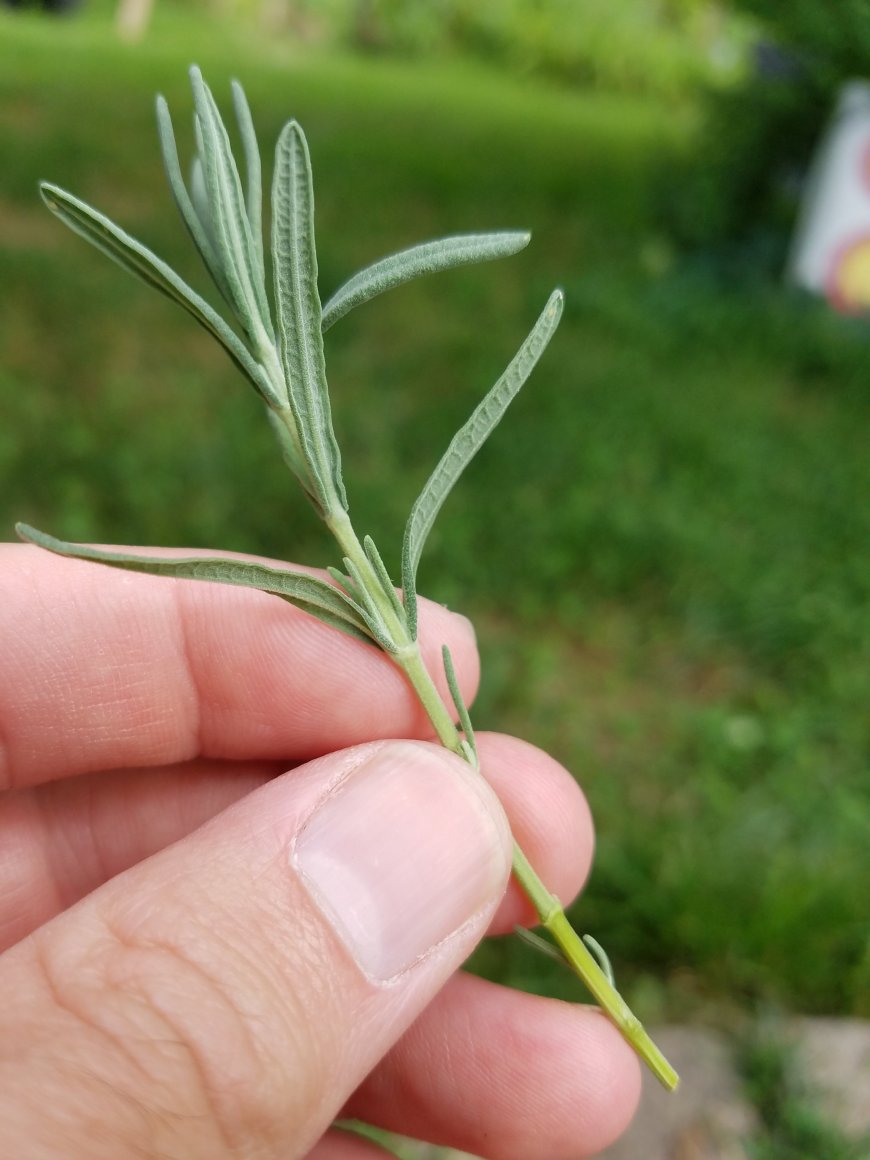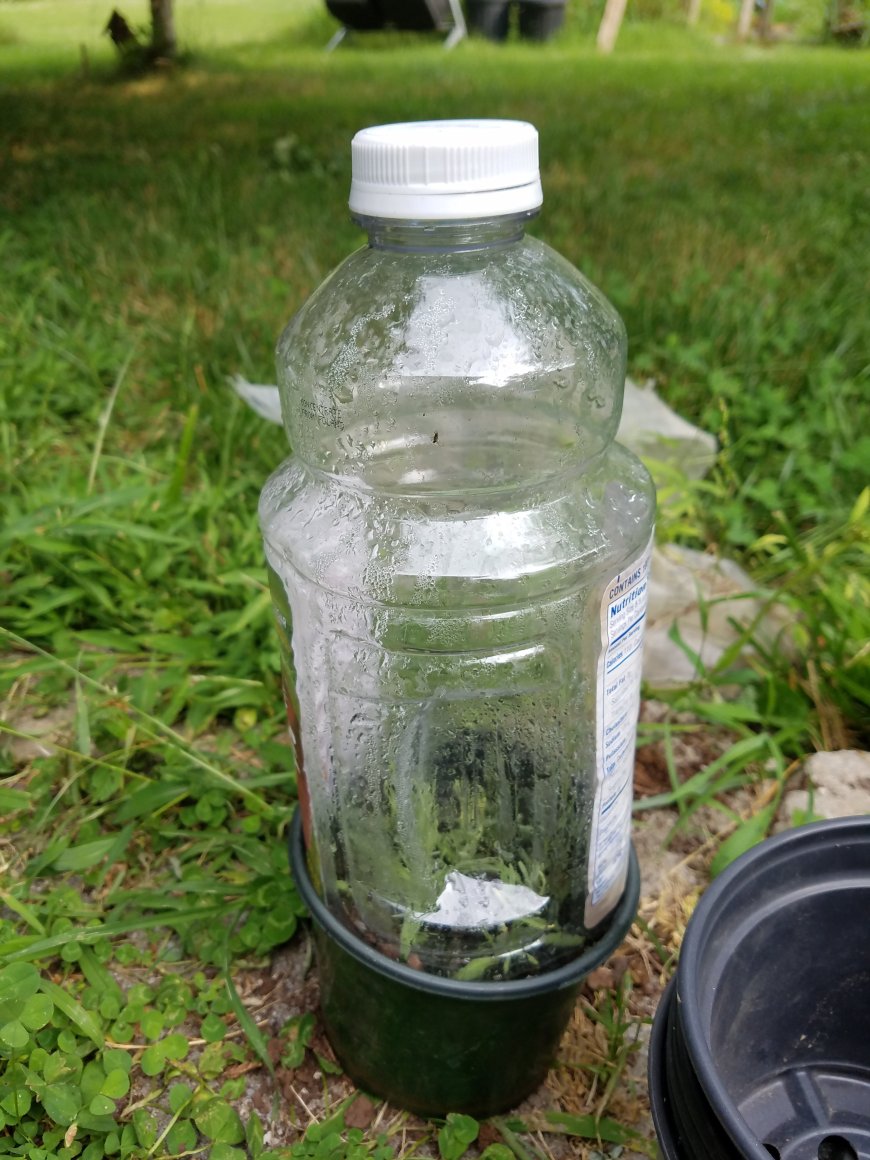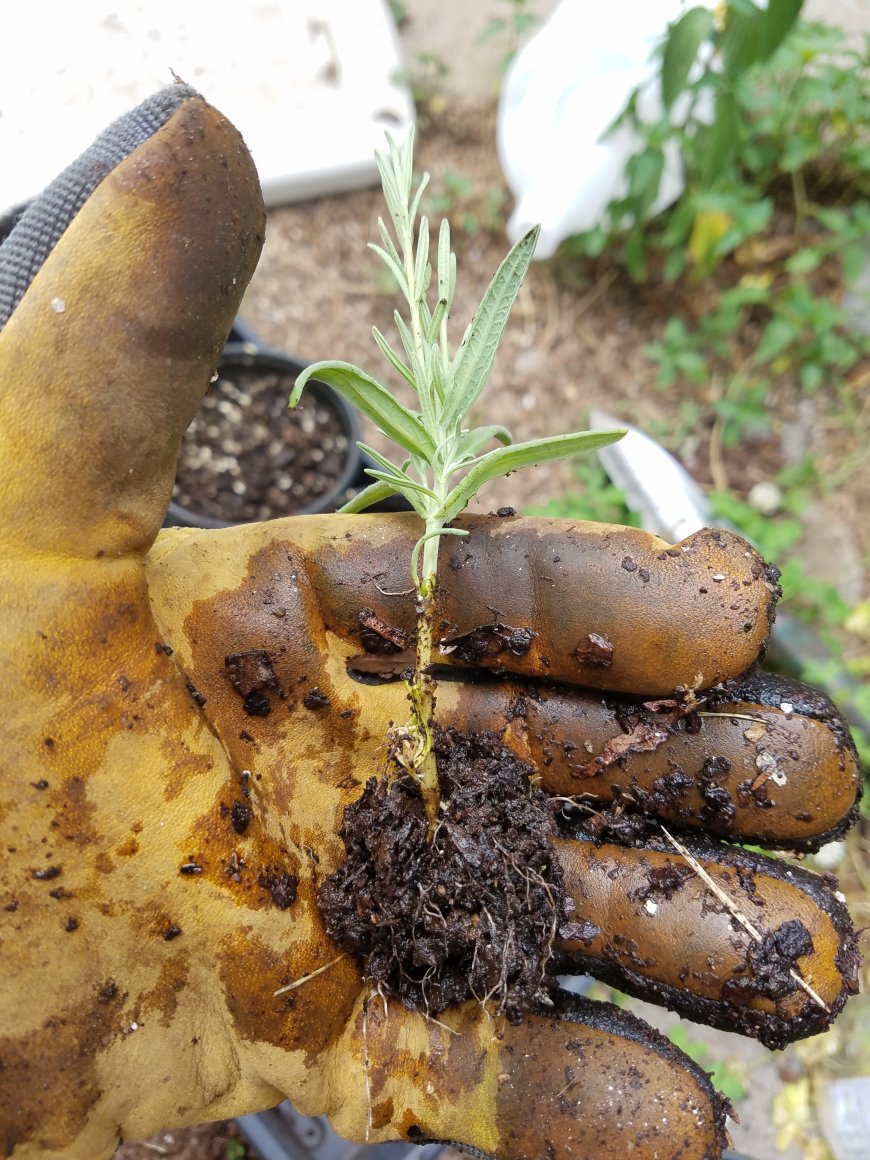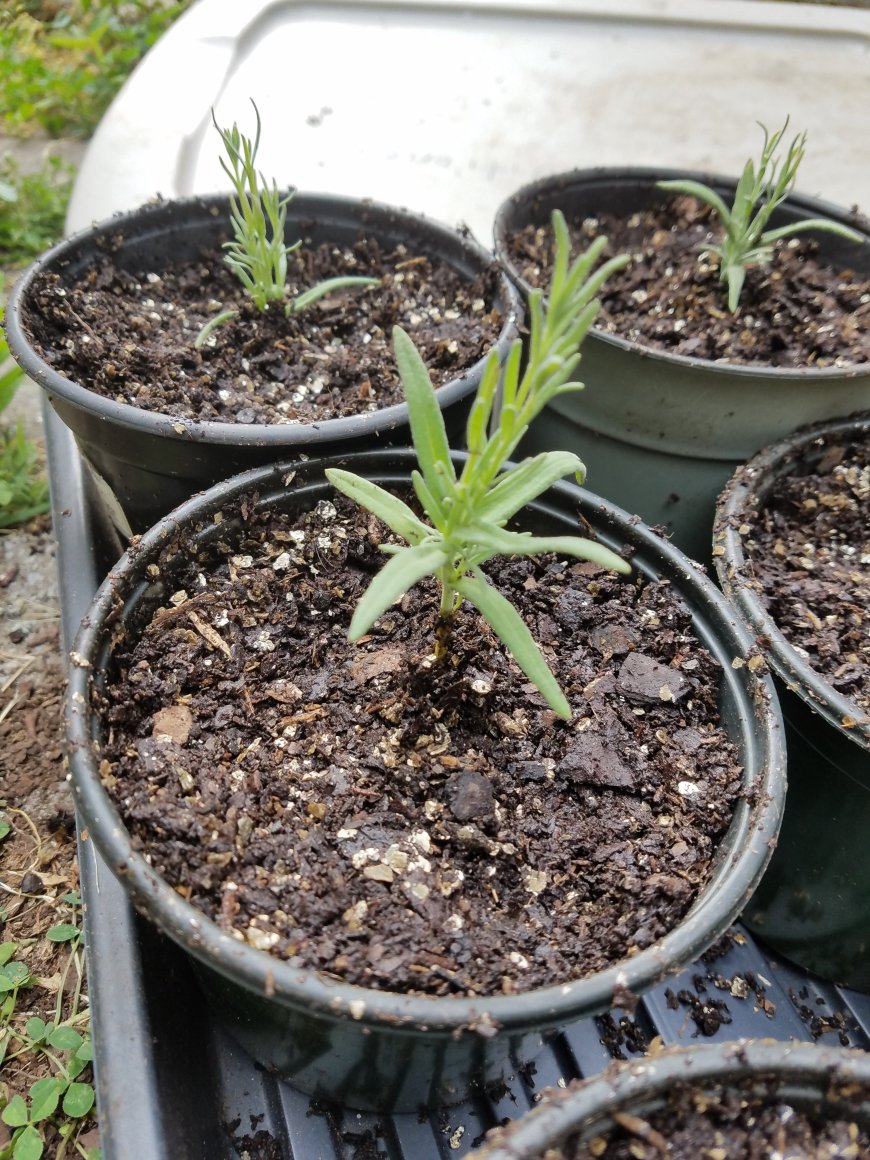
Who wouldn’t want to make more lavender from cuttings? Lavender is a great perennial plant to have around the garden and is an easy one for home gardeners to propagate. Designers use it in knot gardens, formal gardens, or even in pots. It smells great when touched and also has insect repellent properties to help keep the bites at bay. Lavender is very simple to propagate through softwood cuttings in the spring through summer.
This post contains affiliate links.
Taking Cuttings of Lavender
Propagating lavender from cuttings is a very simple process. The cuttings here are from Lavendula augustifolia but other varieties can be propagated using the same method. Just pick a 4 inch cutting and strip the lower half of leaves off. Be careful when doing so because the soft stem can break and the cutting may not be suitable to use. Just be gentle. The picture below is a perfect example of what your lavender cutting should look like. Once you have the cutting pop it in a little jar of water so it doesn’t dry out any while you take your cuttings.

Rooting Hormone
I often use rooting hormone for many types of cuttings including lavender, but it isn’t necessary. Rooting hormone does speed the rooting process and makes them root more reliably. For the cuttings in this post I didn’t use rooting hormone and they rooted just fine. After I take the cutting (and dip in rooting hormone if using it) I place the cut end in the rooting medium. In this case I used an organic garden soil mix. These days I’m using a 50/50 mix of coir (from coconuts) and sand for a rooting medium and I really like how it works.

Cover the Cuttings to Maintain Moisture
After sticking the cuttings in the soil I covered it with a cloche. A cloche is essentially a humidity dome to help the plants retain moisture. For the cloche I cut the bottom off of a juice bottle that happened to have the same circumference of the interior the pot I was using.

Then I watered and waited. I also placed the cutting in a plant tray that would hold water. Essentially I bottom watered the cuttings throughout the process. I opened the cloche a few times but not very often. The majority of the watering happened from the bottom. If your cuttings are staying too moist take the lid of the container off. Also NEVER put the cloche in sunlight. You want indirect light like the kind of light you have under a nice shade tree. Direct sunlight will cook your cuttings.
Lavender Rooting
In about 6 weeks I checked the roots and discovered that 5 of 6 cuttings rooted. 3 of the lavender cuttings rooted great with 1 inch little root balls that formed. 2 of the lavender cuttings had roots but were not very extensive. I potted all six cuttings into larger pots and put back in the greenhouse for a while. Be careful when potting them up do not disturb the roots or remove the rooting medium you used. Breaking the roots while transplanting may slow growth.

Some Helpful Tips for Rooting Lavender

- If the cuttings you have available have flower buds on the tips pinch them off. You don’t want energy taken away from rooting.
- The cloche helps keep humidity present around the cuttings. If a cutting dries out that can be the death of it. If you don’t have a plastic bottle to use a plastic bag will work.
- I didn’t use any rooting hormone but it may have improved rooting if I had.
Taking cuttings can be a lot of fun. Especially when you can save money on filling your garden with plants! See more on plant propagation.
Can you Propagate Lavender Cuttings in Water?
With how easy it is to propagate lavender in soil I wouldn’t even bother with trying to root lavender in water. Water is great for easy plants like coleus or basil but plants in general prefer to have a dark environment for root formation. Can it be rooted in water, yes, but it’s better to root lavender in a soil medium.
Plus when roots do form having soil all around them already provides them with nutrition right away. Water cuttings will probably work but I recommend using the method I have described in this post.
What Other Methods are used to Propagate Lavender?
Layering Lavender
You could also try layering lavender branches. Layering is where you root the stem of the plant by laying it on the soil and pinning it. A rock or brick can be used to hold the branch in place. Once roots have formed on the branch you can sever the branch from the stem and pot it or plant it.
Growing Lavender from Seeds
Lavender grows well from seeds and this is a great way to add varieties you have trouble finding locally to your garden.
Growing Lavender
Lavender is a fairly trouble free plant if you give it the right conditions. Lavender likes a full sun location and well drained soil. Avoid planting lavender in full shade but it can tolerate partial shade. It just won’t bloom as well in the partial shade as it would in the sun.
Lavender is a herb/perennial that does very well in pots and can survive some dry periods just fine. In other words it is drought tolerant. Avoid boggy and wet soils as they can induce rot to the plant roots.
Lavender has been hybridized by many breeders over the years. L. augustifolia (English lavender), L. stoechas (Spanish Lavender), Lavandula x intermedia (Lavandin) are three of the more common species of lavender and flower at different times.
Uses for Lavender
Lavender has a lot of uses around the home including potpourri, cut flowers, dried sachets, soap, scented satchels and pillows, essential oils, and even in the kitchen. As a cooking herb lavender leaves may be used as rosemary and are often used when cooking lamb. The flowers can be used in deserts!
Pruning Lavender
Lavender can be pruned regularly after the flowers are produced to enjoy. You can cut the flowers then give the lavender a trim or you can wait until the flowers have finished blooming and cut them after that. This will happen about twice per season, once in the spring and once in the late summer.
Lavender Attracts Pollinators
Bees flock to the lavender when it is in bloom and the butterflies are soon to follow. It’s a great plant in my garden since I want to attract as many pollinators as possible. As an added bonus the deer don’t enjoy it and leave it alone.
Lavender Growing Guide
| Botanical Name | Lavandula spp. |
| Common Names | Lavender, English Lavender, French Lavender, Spanish Lavender |
| USDA Hardiness Zones | 5–9 (varies by species) |
| Sun Requirements | Full sun (6–8+ hours of direct sunlight daily) |
| Water Needs | Low; drought-tolerant once established. Water deeply but infrequently. |
| Soil Requirements | Well-draining soil; sandy or rocky loam preferred; pH 6.5–8.0 |
| Mature Size | 12–36″ tall and wide, depending on variety |
| Bloom Time | Late spring to early summer (some rebloom into fall with deadheading) |
| Growth Habit | Bushy, mounding perennial or subshrub |
| Fertilizer Needs | Minimal; avoid rich soil and high nitrogen to prevent legginess |
| Pruning Tips | Light prune after flowering; cut back by one-third in early spring |
| Propagation Methods | Softwood cuttings, hardwood cuttings, division (rare), seeds (less reliable) |
| Pests/Diseases | Generally pest-free; root rot if overwatered |
| Companion Plants | Rosemary, sage, thyme, echinacea, ornamental grasses |
| Pollinator Friendly? | Yes. Excellent for bees and butterflies |
| Deer Resistant? | Yes |
If you found this post helpful subscribe to the email list and get new articles sent to your email!
More Plant Propagation
How to Propagate Hardwood Cuttings of Russian Sage
The other day I had an idea. Instead of taking my pruned Russian sage branches and just dumping them in the compost, I thought what if I tried to make cuttings from them? I’ve propagated Russian sage cuttings very easily in…
8 Popular Plant Propagation Posts!
Since so much of the garden right now is suffering from lack of adequate rainfall I thought it might be a good time to look back at a few past plant propagation posts. Some of these are favorites of mine and…
How To Propagate Salvia from Cuttings
Salvia is one of my favorite perennials to propagate and spring and summer are the best times to do root cuttings of salvia from stem tip cuttings. Pretty soon our gardens will be filled with salvia blooms and you’ll see why…
Float Testing Acorns for Viability
The majestic oak is one of Tennessee’s most beautiful native trees. It’s also an extremely useful tree for our local wildlife as it can host over 200 species of insects and animals. You can see why you would want to cultivate…
How to Propagate a Dogwood Tree from Cuttings (Cornus florida)
I successfully rooted a Florida dogwood (Cornus florida) from a cutting! This is a tree that’s been tricky in the past for me to propagate, and I finally had some success I think is worth sharing. In this post, I’ll walk…
Propagating Mums for Profit
It’s kind of an odd subject to bring up during spring but propagating mums for profit takes time. Spring is when you have to get started for fall mum sales. For the purposes of this article we are talking about the…
Discover more from Growing The Home Garden
Subscribe to get the latest posts sent to your email.







